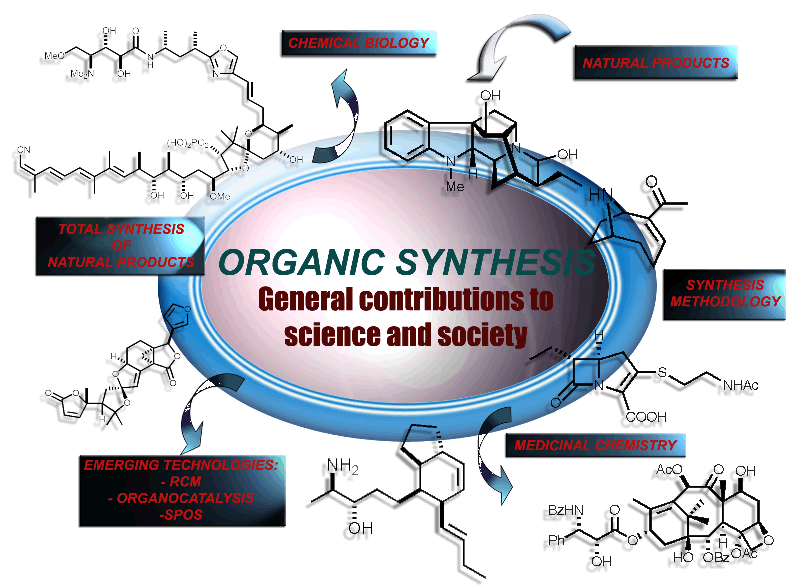|
Construction of complex natural and non-natural compounds with multiple chiral centers in enantiopure form (single optical isomer) is of paramount importance not only to the pharmaceutical industry but these compounds also find their rapid applications in the development of new materials. The development of feasible synthetic routes to such complex structures requires the existence of synthetic methodology capable of performing highly efficient asymmetric induction processes. This can consist of the independent creation of a new or an independent chiral center, in which case reagent controlled external asymmetric processes play a central role. Very often the molecule already contains one or more stereogenic centers, in which case it is desirable to utilize the existing chirality in the creation of new chiral centers (internal asymmetric induction).
The toughest acid test for any synthetic method comes from its applicability to the synthesis of complex natural products . Such target compounds typically provide a wealth of opposing functionalities, require a careful retrosynthetic planning to avoid the interference of complicating transformations, and very often also lead into total syntheses which might best be described as 'monumental', both in terms of the complexity of the strategy and the usage of man-years involved. A very good case in point is erythronolide, whose synthesis was once considered to be 'so difficult that its conquest cannot be conceived within the foreseeable future' by perhaps the greatest creative mind ever in the history of synthetic organic chemistry, R.B. Woodward. Only 25 years later , his own group, with the aid of no less than 50 co-workers , actually achieved the first total synthesis of this molecule, and it took only another decade before the same task could be achieved within the confines of a single Ph.D. thesis! The main body of activities of our group relies on the development of novel methods for the construction of C-C bonds which themselves display a chirally biased environment for further elaboration into multiply chiral functional molecules and the methods to actually obtain such complex constructs. The main objective of our research efforts is to develop novel synthetic methods capable of being transferred into (industrially) applicable synthetic technologies. Our main aim is to develop sophisticated synthetic methods, which will allow the construction of complex stereochemical arrays in only few steps. The methodologies selected are based on the realizations that the most desirable ones are the ones involving catalytic asymmetric transformations, i.e. external asymmetric induction [Koskinen, A.M.P. Asymmetric Synthesis of Natural Products , John Wiley & Sons, Chichester, 1993]. The second best choice is the utilization of existing chiral starting materials from the chiral pool, which typically requires development of bold new synthetic transformations. Our research projects have a strong emphasis on biologically important phenomena, with possible medicinal and pharmaceutical applications: those related to cellular recognition (total synthesis of calyculin; carbohydrate and glycomimetic chemistry, with the aim of understanding intracellular and intercellular signal transduction processes); those related to already known potential drugs (taxol and its analogues for cancer; amino sugars as glycosidase inhibitors); mimetics (peptide mimetics based on non-natural amino acids and carbohydrate mimetics). The following will give a brief presentation of our current activities based on the chemistry aspects. As complex target structures we have chosen molecules which exhibit a number of difficult sub-structural units, and which themselves can be of enormous value in therapy and elucidation of the chemical pathways involved in cellular communication processes.
|

